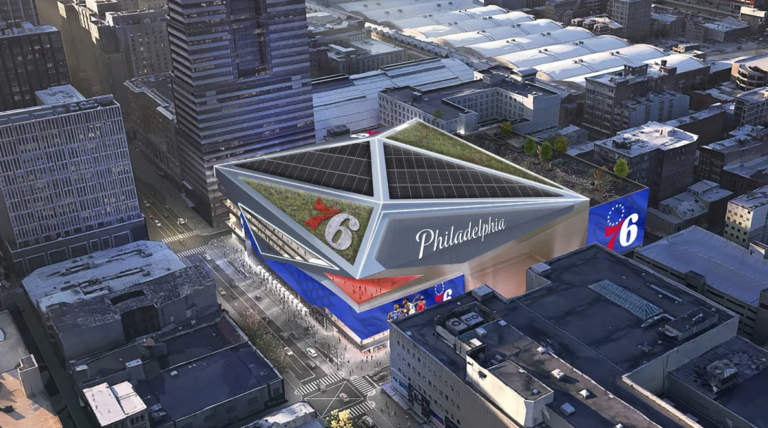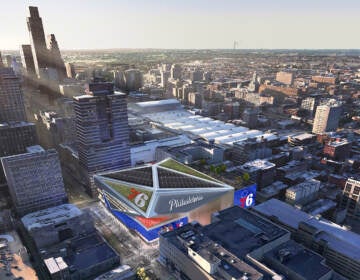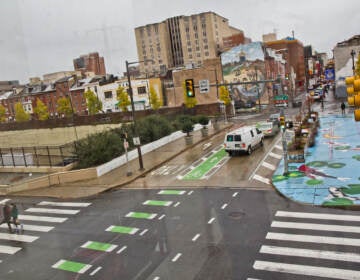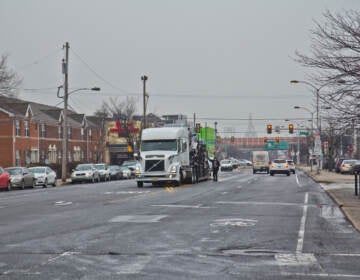A new Sixers arena in Center City is not a sure shot
The proposal to erect the arena on a full city block adjacent to Chinatown draws swift condemnation, excitement, skepticism — and plenty of buzz.

The proposed Sixers arena would be called 76 Place at Market East. (76 Place)
Got a question about Philly’s neighborhoods or the systems that shape them? PlanPhilly reporters want to hear from you! Ask us a question or send us a story idea you think we should cover.
Philadelphia is buzzing with the news that Sixers ownership has teamed up with a real estate developer to try to bring a new NBA arena to Center City.
Reaction to the $1.3 billion proposal for 10th and Market Streets is mixed, however, with at least one group gearing up for a fight amid an early chorus of excitement and optimism.
The proposed development, dubbed 76 Place, would sit steps away from Chinatown, a neighborhood that has a history of sparring with developers in the name of community preservation. There, opposition and skepticism appear to be building.
“This is not the first time that big developers proposed to build something without our input: the baseball stadium, the casino, to name a few,” said Wei Chen, civic engagement director at the Chinatown-based nonprofit Asian Americans United, in a press release. “We have defeated each one of them. We are ready to fight to protect our community.”
An unwelcome new neighbor
Roughly two decades ago, a proposal to build a stadium for the Phillies on Vine Street between 11th and 13th died amid opposition from Chinatown businesses and residents. A few years later, the community beat back a proposal for a Foxwood casino nearby.
Parts of Chinatown are already undergoing gentrification, which some fear is fueled by amenities such as the Rail Park, which opened above Chinatown North in 2018.
“They should just pick a different area,” said Donna Vo, who works at Bonchon, a chain restaurant in Chinatown, and worries the arena would cause property values in the neighborhood to increase. “That’s going to be hard on the people that are already living here because everyone’s already struggling enough to pay rent.”
The South Philly-based Southeast Asian Mutual Assistance Associations Coalition (SEAMAAC) plans to organize against the arena proposal with its “full weight,” said Thoai Nguyen, the organization’s CEO. He expects the project to face fierce opposition from not only the Chinatown community, but other communities in solidarity.
Nguyen said he felt “absolute anger” when he read about the proposal in the news.
“This is a long line of historical attempts by the powers that be to really put a chokehold on Chinatown’s growth and vibrancy,” he said, referencing construction of the Vine Street Expressway through Chinatown in the 1980s, the Gallery — since remodeled into the Fashion District — to the south of the neighborhood in the 1970s, and the Pennsylvania Convention Center to the west in the early 1990s.
Nguyen worries years of construction will burden the Chinatown community with noise and air pollution, and that only wealthy developers and investors will profit.
“For most Philadelphians or tourists that visit Philadelphia, Chinatown is seen as this place where you go to eat and you go buy gifts,” he said. “What they don’t know, there are hundreds of families that live in the community.”
John Chin, director of the Philadelphia Chinatown Development Corporation (PCDC), said he doesn’t know enough about the project yet to support or oppose it, but hopes it could be an opportunity to fix some issues with the current Fashion District, which he said cuts Chinatown off from neighbors to the south.
Still, he’s concerned the project could swamp the neighborhood with traffic, or contribute to gentrification. He worries it could be an echo of Washington D.C.’s Capital One Arena, which contributed to the decline of that city’s Chinatown after it was built under a different name more than two decades ago.
“We do not want to go down that path that the Washington, D.C., Chinatown went down,” he said.
An FAQ section of the website the arena development team set up states that the 76ers are aware of past development efforts in Chinatown and why they were opposed.
“The team is aware of those efforts and the threats they posed for the community, which is why this project is being approached differently,” the website reads. “We are proposing to replace one entertainment complex with another, and will not displace any residents in Chinatown.”
The development team also promised to create a community benefits agreement — potentially including programs related to promoting local business, workforce participation, affordability, neighborhood preservation, and community access to the arena — and work with surrounding neighborhood stakeholders to make sure the project benefits everyone.
Chin, of PCDC, said his first priority for a community benefits agreement would be affordable housing in Chinatown. Nguyen, of SEAMAAC, said a CBA would have to invest $10 to $20 million annually in education, youth services, public health and wellness for “Philadelphia’s most marginalized community.”
“Short of that, for lack of a better word, it’s just bulls**t,” he said.
Reviving a struggling commercial corridor
At the same time, city leaders are largely praising the nascent proposal, which they say would be an economic boon for the blocks comprising Market East, a commercial corridor that has struggled to reposition itself, even with developers investing millions.
“I don’t see how this project can be something that would be viewed negatively for the city,” said Mo Rushdy, vice president of the Building Industry of Philadelphia.
In the 1920s, Market East was a bustling shopping district, at times featuring eight major department stores, including Wanamakers and Strawbridge and Clothier.
But since the 1970s, the stretch has struggled to regain that prominence, but not for a lack of effort. The Gallery, the Pennsylvania Convention Center, The Fashion District, none of them have helped bring the area fully back to life.
Paul Levy, the longtime president of the Center City District, said a new basketball arena could be a catalyst for a lasting turnaround, in part because the project would likely attract new businesses and noticeably more foot traffic to the area.
“This is by no means a panacea. It’s not a silver bullet. It’s just one more important use that gives us a lot of different activity and diversity coming into Center City, and that’s key to our future,” said Levy.
Getting city government on board
The proposed arena is expected to take years to complete. The development team, headed by David Adelman, predicts the doors won’t open to fans until sometime in 2031, the year the Sixers’ lease expires at the Wells Fargo Center in South Philadelphia.
Well before construction starts, Adelman and the Sixers will work on securing support from nearby neighbors, City Council and the city’s zoning board, the independent body empowered to make legally binding decisions about what proposed developments get built.
Rushdy said all of that could take at least two years, and likely yield at least one community benefits agreement — a contract signed by a developer and typically a civic group that details how a project will positively impact the immediate. These agreements usually include provisions that address issues of walkability, safety, and traffic.
“It’s not going to be easy. It’s going to be a tough road because it’s a large job with a lot of impact. But in my opinion, this is something that, deep down, emotionally, community stakeholders, Council, anyone that wants good for the city and loves this city” will support, said Rushdy.
Councilmember Mark Squilla, whose district includes the proposed site, said he’s excited about the prospect of the new arena, in large part because of its potential to be an economic engine for the area. He said he is also pleased that the project is not expected to require any taxpayer dollars to complete.
“As long as there’s an open dialogue … I think this could be different,” said Squilla. “I’m optimistic.”
In a statement, Council President Darrell Clarke, echoed his colleague, saying a downtown arena offers “the promise and potential of significant economic opportunity,” while stressing that the Sixers must be “transparent and sensitive to the real needs of the people who live and work in the neighborhoods near the proposed site.”
“While I would have preferred to see the Sixers’ plans for an arena on the Delaware River waterfront move forward, I think we need to give this new proposal all the attention, scrutiny and due diligence that it deserves,” said Clarke.
Will the current nearby transit hub be good enough?
The arena developers have no plans to add parking as part of the project, explaining on the 76 Place website that, “We envision this project as a site that relies on public transit. … For those who chose to drive, the site is within a half- mile radius of 29 parking garages operating with significant spare capacity.”
For now, it’s unclear if the Sixers’ proposal would require SEPTA to complete any underground construction work.
Running beneath or near the proposed arena site, are 13 Regional Rail lines operating out of Jefferson Station. There are also stations nearby for the Broad-Ridge Spur, the Broad Street Line, PATCO and the Market-Frankford El, the “workhorse” line the agency expects to transport the most fans to and from games if the project goes forward.
Spokesperson Andrew Busch said the project’s timeline coincides with a 12-year capital improvement effort that includes renovations to stations and tracks, including stops along the Market-Frankford El and the Broad Street Line that are not currently ADA accessible.
SEPTA is also preparing to replace its entire fleet of train cars that service the Market-Frankford line, he said.
“Looks like these will fit together very nicely,” said Busch of the planned upgrades and the stadium proposal.

Subscribe to PlanPhilly
WHYY is your source for fact-based, in-depth journalism and information. As a nonprofit organization, we rely on financial support from readers like you. Please give today.









